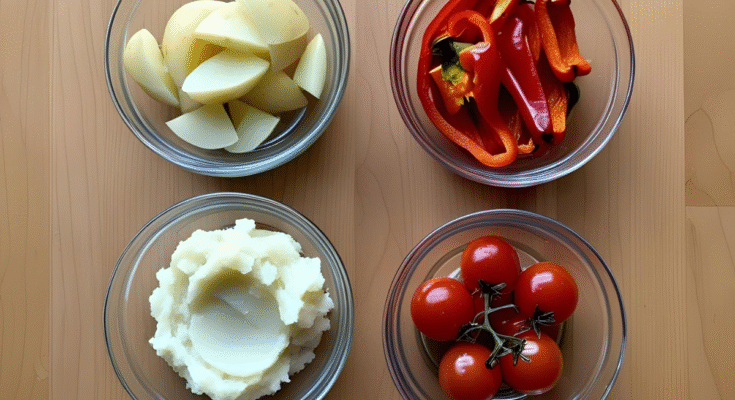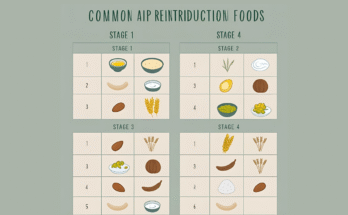It can be alarming when you reintroduce nightshades on the AIP diet. These foods are frequently associated with autoimmune flare-ups, joint pain, and digestive problems. However, if you’ve made some improvements during your elimination process, the reintroduction can be the first step to determine your food tolerance.
This guide walks you through how to reintroduce nightshades on the AIP diet safely, slowly, and confidently. For a full overview of the protocol, check out our Complete AIP Diet Guide.
What Are Nightshades?
Nightshades are a family of plants that include:
- Tomatoes
- Potatoes (not sweet potatoes)
- Eggplants
- Peppers (bell, chili, jalapeño, cayenne, etc.)
- Paprika
- Goji berries
These foods are loaded with compounds such as capsaicin, solanine, and lectins, which may trigger inflammation or allergic reactions in sensitive people.
Why Nightshades Are Eliminated on AIP
So, in the AIP elimination phase, we gotta ditch nightshades. Why? Well, they can make your gut leaky, amp up your immune system too much, and even trigger joint pain, skin issues, or tummy troubles. Lots of folks with autoimmune conditions say they feel way better once they cut them out. That’s why you have to be super careful when you try to bring them back!
When to Bring Nightshades Back
You should only start thinking about reintroducing nightshades when a few things are true:
- You’ve been sticking to the elimination phase for at least 30 to 90 days.
- Your symptoms have gotten way better or are stable.
- You’ve already tried bringing back some less tricky foods successfully (like egg yolks or seeds).
If you’re still having active flare-ups, just wait longer before trying nightshades.
Which Stage to Reintroduce Nightshades on the AIP Diet
Nightshades usually come in at Stage 4 of the AIP reintroduction. That means they’re one of the last things you should test.
How to Reintroduce Nightshades, Step-by-Step
Step 1: Pick the Mildest One First
Start with a nightshade that’s less likely to cause issues, like peeled, cooked white potatoes or bell peppers. Steer clear of hot peppers or super spicy stuff at first.
Step 2: Keep it Simple
Don’t go for processed, fried, or mixed-up dishes. Just steam or bake a peeled potato, or roast a bell pepper with only olive oil and sea salt.
Step 3: Eat a Little Bit and Wait
- Take 1/2 teaspoon of the cooked food.
- Wait 15 minutes.
- Watch for any immediate reactions (like tingling, itching, nausea, or feeling anxious).
- If nothing happens, eat 1 full teaspoon, then wait 2–3 hours.
- Still no reaction? Go ahead and eat a full serving size and then keep an eye on how you feel for the next 24–72 hours.
Step 4: Write Down Everything
Use a tracker to note:
- What you ate
- How it was made
- When and how much
- Any changes you notice – physical, emotional, or how you’re thinking
Step 5: See How it Went
If you get any bad symptoms (like joint pain, bloating, or a rash), stop immediately and go back to your elimination diet until you feel better. You can try again in a few weeks.
If you don’t have any symptoms, awesome! You can include that nightshade occasionally or keep testing other varieties.
Suggested Order for Trying Nightshades
Here’s a general order, going from the least likely to most likely to cause problems:
- Peeled white potatoes
- Bell peppers (cooked)
- Cherry tomatoes (peeled and cooked)
- Eggplant (well-cooked)
- Paprika (a small amount, cooked into food)
- Hot peppers (save these for last, and only if you’ve tolerated everything else well)
What if You React?
A negative reaction can feel frustrating, but it’s really important information! Here’s what to do:
- Stop eating the food right away.
- Go back to your basic AIP elimination diet.
- Support your gut with healing foods (think bone broth, cooked greens, fermented foods).
- Wait until all your symptoms are gone before trying any new foods.
You can always try that food again in a few months. Your tolerance might improve as your gut continues to heal.
Tips for Success
- Only reintroduce one food at a time.
- Wait at least 3–5 days between trying new foods.
- Use a food journal or tracker – it’s so helpful!
- Don’t combine nightshades when you’re testing.
- Cook foods thoroughly to reduce any potential irritants.
- Try to manage your stress, because it does affect how reintroductions go.
The Emotional Side of Bringing Back Foods
Reintroducing foods isn’t just about your body – it can be emotional too. You might:
- Feel anxious about having a flare.
- Be scared of losing the progress you’ve made.
- Miss your favorite dishes a lot.
These feelings are normal. Go slow. Celebrate every little step forward. And remember: the whole point of AIP isn’t to avoid foods forever. It’s to figure out a personalized, nourishing way of eating that truly supports you.
FAQs
Can I reintroduce nightshades early? Nope. Nightshades should be Stage 4 – only after your immune system is more stable and you’ve handled easier foods.
Why are nightshades inflammatory? They have compounds like solanine, capsaicin, and lectins, which can increase inflammation or mess with gut health in sensitive people.
Can I tolerate some nightshades but not others? Absolutely! Lots of folks can handle potatoes but not tomatoes, or bell peppers but not hot peppers. Test each one separately.
How long should I wait between nightshade reintroductions? Wait at least 5–7 days between testing different nightshades. If you had any reaction, wait even
Key Takeaway
Bringing nightshades back on the AIP diet is a big step towards getting your food freedom back and truly understanding your body. With patience, tracking, and good timing, you can figure out what works for you – and what doesn’t – without feeling scared.
Take it one food at a time, be mindful, and trust your healing journey!



